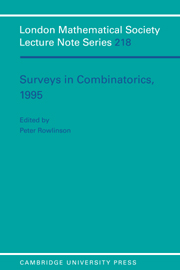Book contents
- Frontmatter
- Contents
- Preface
- Euclidean geometry of distance regular graphs
- Large sets of Steiner triples
- Searching with lies
- Spin models for link invariants
- Computational Pólya theory
- Mixing of random walks and other diffusions on a graph
- Cayley graphs: eigenvalues, expanders and random walks
- Construction and classification of combinatorial designs
- Modern probabilistic methods in combinatorics
Construction and classification of combinatorial designs
Published online by Cambridge University Press: 05 May 2010
- Frontmatter
- Contents
- Preface
- Euclidean geometry of distance regular graphs
- Large sets of Steiner triples
- Searching with lies
- Spin models for link invariants
- Computational Pólya theory
- Mixing of random walks and other diffusions on a graph
- Cayley graphs: eigenvalues, expanders and random walks
- Construction and classification of combinatorial designs
- Modern probabilistic methods in combinatorics
Summary
Introduction
One important area of research in Combinatorial Mathematics is that of the existence, construction and enumeration of designs of various different sorts. Given the general conditions denning a design it is often the case that very simple necessary conditions for its existence can be derived in terms of the so-called parameters of the design, but by and large it is very difficult to prove or disprove that the conditions obtained are also sufficient. Thus, even if necessary conditions are obtained we are generally left with either an immediate non-existence result or the problem of attempting to establish the existence by an explicit construction of the design. Of course, if the design concerned does not actually exist then this can often be a lengthy process. The first example that springs to mind is a projective plane of order 10, where the necessary conditions obtained by the Bruck-Ryser-Chowla Theorem do not disprove its existence, and yet the plane does not exist [16].
If the parameter sets of the designs are ‘small’ then it has often been the case that direct computer-free methods have led to a construction, and in some cases a complete classification has been achieved. In certain sporadic instances with ‘large’ parameter values it is also possible to construct and classify the corresponding designs without using a computer, but it is generally true that the larger the parameter set the more difficult the problem of determining all non-isomorphic designs with that given set of parameters.
- Type
- Chapter
- Information
- Surveys in Combinatorics, 1995 , pp. 191 - 214Publisher: Cambridge University PressPrint publication year: 1995
- 2
- Cited by

